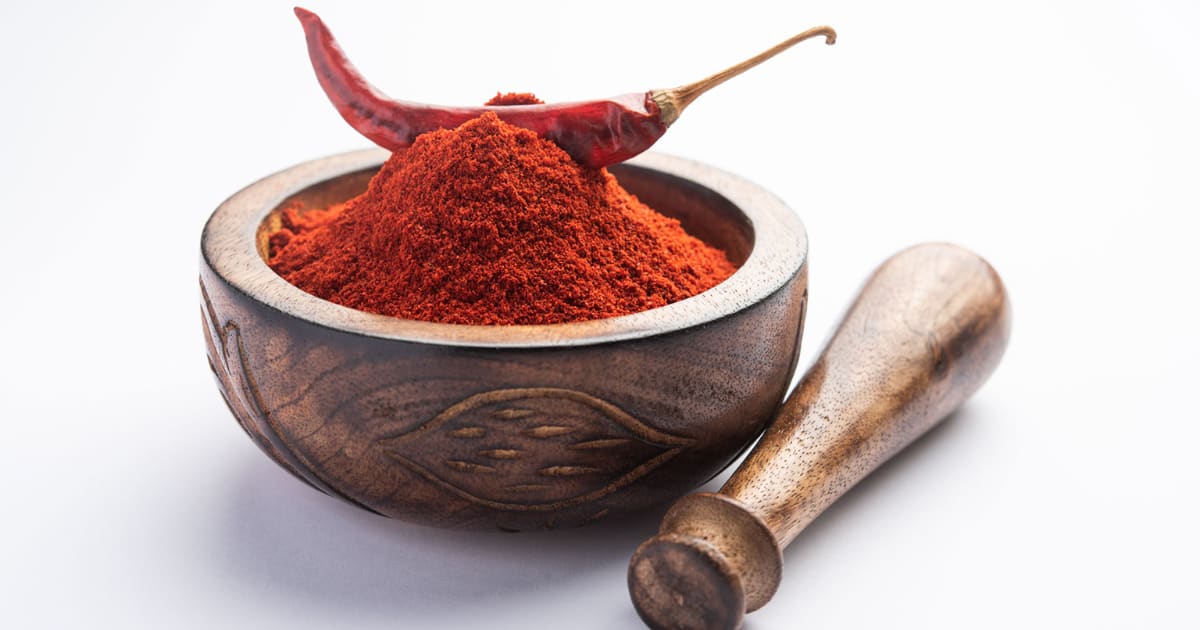Indian cuisine is renowned for its liberal use of spices that add vibrant colors, incredible aromas, and delightful flavors. Two staple chili powders are Deggi Mirch and Kashmiri Mirchi. They impart a signature red hue and mild heat to dishes across India.

But what exactly sets these ground chilies apart? Read on to discover the differences between Deggi Mirch and Kashmiri Mirchi and how to use them perfectly.
What is Deggi Mirch?
Deggi Mirch is a traditional Indian spice blend from mild Kashmiri dried red chilies and bell peppers. It has a beautiful deep red color, adding a mildly spicy flavor and vibrant color to dishes like curries, stews, soups, and more.
Deggi Mirch measures 1,500 to 2,000 on the Scoville scale, providing a gentle heat. Deggi Mirch releases more of its spiciness and unique flavor when roasted in oil. It's similar to paprika but with an extra kick.
What is Kashmiri Mirchi?
Kashmiri Mirchi refers to a variety of high-quality red chilies grown in the Kashmir region of India. They can be used whole, powdered, or slit into pieces. Kashmiri Mirchi powder provides meals with a bright red hue and a mild flavor, usually measuring 1,000 - 2,000 Scoville units.
The chilies are small with minimal spice, making them ideal for dishes like tandoori, which become more aromatic when roasted. They are perfect for imparting a vivid red color to foods that readily absorb color.
How are Deggi Mirch and Kashmiri Mirchi Different?
While both Deggi Mirch and Kashmiri Mirchi offer mild heat and deep red hues, there are some key differences between the two spice blends:
- Deggi Mirch is similar to mild paprika in flavor. It provides a deep red color without too much spiciness, making it perfect for gravies, stews, and soups.
- Kashmiri Mirchi has a bit more heat and spice compared to Deggi Mirch. However, it is still milder than other Indian chili varieties like Guntur and Mathania.
- When roasted, Kashmiri Mirchi becomes more aromatic and is well-suited for clay oven dishes like tandoori.
- Deggi Mirch has a sweeter, smoother flavor with more heat than Kashmiri Mirchi.
When to Use Deggi Mirch
If you enjoy flavorful, mildly spicy Indian food, Deggi Mirch is a great alternative to regular chili powder. It will provide curries, dals, parathas, and more with a gentle warmth, vibrant red color, and rich flavor without being overly hot. The exact amount to use depends on your tolerance for spice, so start with a small amount and adjust accordingly.
According to Chef Naved at Dishoom restaurant, Deggi Mirch is indispensable in their kitchen. He uses it in many of their signature spice blends and dishes like chaat, samosas, okra fries, curries, biryanis, and more. At home, beyond curries, Deggi Mirch can be used in soups, stews, and anywhere you want extra color and mild heat.
What are Good Deggi Mirch Substitutes?
If you can't find Deggi Mirch, possible substitutes include:
- Kashmiri Chilli Powder - Provides a similar red color with even less heat.
- Hot Paprika - Adds mild heat and a rich red hue.
- Cayenne Pepper - Imparts more heat but has a similar red color. Use sparingly.
- Smoked Paprika - Contributes great flavor but not spiciness.
- Garam Masala - Mix with some cayenne to approximate the heat level.
Key Takeaways
Here are the key points to remember about Deggi Mirch vs. Kashmiri Mirchi:
- Deggi Mirch - Traditional blend of Kashmiri chilies and red bell peppers; provides vibrant red color, mild paprika-like heat, and rich flavor.
- Kashmiri Mirchi - Powder made from Kashmiri chilies, milder than Deggi Mirch, with more aromatic flavor when roasted.
- Deggi Mirch works well in wet dishes like curries and stews. Kashmiri Mirchi shines in tandoori and other clay oven dishes.
- Both offer mild heat, around 1,000-2,000 Scoville units, but Deggi Mirch is slightly hotter.
- Popular in Indian cuisine, it adds mild spice and bright red color.
- You can substitute one for the other in recipes without much difference.
FAQ
What type of chili is used in Deggi Mirch?
Deggi Mirch contains a blend of Kashmiri dried red chilies and red bell peppers. The Kashmiri chilies provide mild heat, while the bell peppers lend sweetness and vivid red color.
Does Kashmiri Mirchi add a lot of heat to dishes?
No, Kashmiri Mirchi is known for being very mild, usually only reaching 1,000-2,000 on the Scoville scale. It provides rich color but little pungency, making it perfect for dishes like tandoori chicken.
Can you use paprika as a substitute for Deggi Mirch?
While they are similar, paprika lacks the mild heat of Deggi Mirch. You can approximate the flavor by mixing sweet paprika with a small amount of cayenne pepper. But for best results, try to find Deggi Mirch powder.
What gives Kashmiri Mirchi its signature red color?
The vibrant red hue of Kashmiri Mirchi powder comes from the rare Kashmiri chilies it contains. These small, mildly hot chilies grown in the Kashmir region of India provide an eye-catching color.
Should Deggi Mirch be roasted before use?
Dry roasting Deggi Mirch in a pan with a little oil helps intensify its flavor and spiciness. But it can also be used straight from the jar in curries, marinades, and more.
Conclusion
Whether you're hoping to turn the heat a notch or just crave bright, beautiful red curries, Deggi Mirch and Kashmiri Mirchi are flavorful friends in your spice cabinet. Both offer gentle, mild heat around 1,000-2,000 Scoville units, but Deggi Mirch packs more punch.
While they can be substituted for one another, Deggi Mirch's paprika-like flavor works well in wet curries and stews, while Kashmiri Mirchi shines when roasted. With their vibrant hues and moderate spice, a touch of these chili powders will elevate any Indian dish.

